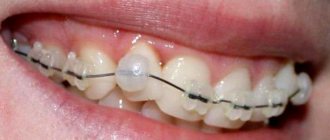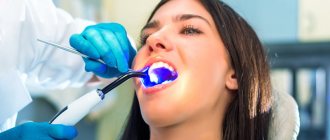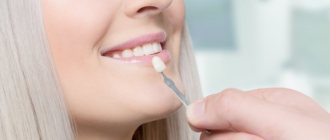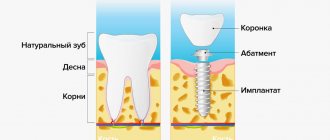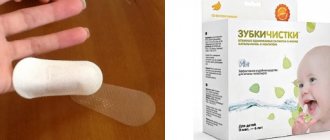Duration of adaptation
Any braces, regardless of their type and material, will take some getting used to. Pain sensations can be of varying intensity, and when wearing lingual systems, diction problems are added to them. Very often, patients complain of rubbing the mucous membrane with metal parts and hooks.
Pain syndrome is caused by the very design of orthodontic appliances. Pressure on the teeth is created by a power arc, which is deformed in advance and has a certain tension force. In an effort to return to its original position, the metal arch literally “pushes” the teeth in problem areas in the desired direction.
It is especially difficult in the first days after installing braces. The tissues in contact with the system are very strong: significant force is required to force them to change position. The degree of pressure depends on the type of anomaly and design features. The stronger the impact, the more complex the defect and the lower the pain threshold, the more inconvenience a person experiences in braces.
On a note!
In most cases, the adaptation period lasts several days, a maximum of a week. It is extremely rare that this period increases due to the ultra-low pain threshold.
Complications when wearing
Ideally, the orthodontist should inform the patient himself about all the consequences that may arise after installing braces.
Some of them are normal for the adaptation period, but there are also complications that may require specialist intervention. Let's look at the most common problems.
Naturally, the presence of a foreign body in the oral cavity will cause a feeling of discomfort. However, after 1-2 weeks, the owner of the system adapts and does not feel the presence of the structure.
Unpleasant sensations in some areas of the gums are considered normal, since under the pressure of the plate the teeth begin to gradually move into the correct position.
This symptom is not observed in everyone; it all depends on the severity of the defect. However, if you encounter it and cannot tolerate it, you can take a pain reliever.
Headache
Often, when a headache occurs, those with braces do not even think about the fact that unpleasant sensations can be caused by wearing the brace.
However, the pressure that braces create on the teeth also transfers to the maxillofacial bones, affecting the nerve endings.
As a result, orthodontic clinic patients may suffer from headaches for some time.
Braces, which are a foreign object, irritate the oral mucosa and cause increased salivation. Therefore, this phenomenon is considered to be the norm.
In addition to the fact that braces cause a feeling of discomfort during the adaptation period, they also cause irritation of the mucous membrane.
Especially, bulky structures can very often injure the surface of the lips, tongue, and cheeks in the first weeks. To avoid this situation, experts recommend using special dental wax.
Gum inflammation
If the soft tissues are inflamed precisely because of the installation of braces, the problem is easily solved by rinsing with anti-inflammatory compounds or massaging them with a soft brush.
The situation is much worse when the disease process was caused by bacteria due to poor hygiene.
Then you need to seek advice from an orthodontist, who, after conducting certain examinations, will prescribe adequate treatment.
Impaired diction
Unfortunately, wearing braces and speech impairment are two integral processes. Especially, diction is affected by lingual structures that are installed on the inside of the teeth.
However, in most cases, the speech impediment resolves over time. Reading aloud helps speed up this process.
How to get used to braces faster
The first week with braces is the hardest, but residual effects can persist for several more days. It is better to think in advance about what to do during this time and plan as many interesting activities as possible. This could be meeting with friends, going to the movies or theaters, or reading exciting books.
On a note!
It is necessary to constantly be distracted and think less about the foreign body on the teeth. The discomfort will not last more than 1 day, so the doctor must recommend individually how to deal with it.
General Tips
Experts have prepared several effective recommendations that will help you minimize the time it takes to get used to braces:
- While sleeping, try not to touch your lips to the pillow; follow this rule at least during the first week after installing the system.
- Keep yourself busy, keep yourself busy and don't sit idle, this will help take your mind off the problem.
- Do not touch the structure with your tongue or hands.
- If discomfort prevents you from falling asleep, try rinsing your mouth with chamomile decoction for 3-5 minutes, take a warm bath and try to relax and distract yourself as much as possible.
- Another good way is to find a like-minded person! This can be done on dental forums, communicate with people, share and get new life hacks to quickly get used to braces.
Please note that discomfort and mild rubbing are considered normal, but if severe pain is involved, you should urgently contact the doctor who installed the orthodontic system. It is important to make sure that the braces are installed correctly, that the structure has not moved out and is correctly positioned on the teeth.
Anti-chafing orthodontic wax
Orthodontic wax is designed specifically to protect the gums and oral mucosa from mechanical damage. They are almost inevitable when parts of the structure come into contact with the lips, gums and inner surfaces of the cheeks. Chafing injuries are especially noticeable during the adjustment period, but can be prevented with wax.
Using orthodontic wax is very simple - it is applied to the problem area after brushing your teeth. In order for the wax to last longer, the teeth and braces themselves must first be dried using cotton swabs or disks.
The wax-coated structure will stop rubbing and will protect against the appearance of bleeding ulcers that may not heal for a long time. It is advisable to remove the wax before eating: although it is safe for the gastrointestinal tract, an eating disorder cannot be completely ruled out.
Important!
It is forbidden to replace wax with chewing gum, as it can cause inflammation of the soft tissues or damage to the braces. If replacement is necessary, beeswax, paraffin or dental silicone can be used instead of orthodontic wax.
What to do if the bracket comes off or the arch in the bracket system breaks?
Every brace wearer has at least once encountered the breakdown of elements of the brace system. You need to take this calmly, but you should return everything to its place as quickly as possible. A broken brace system not only does not correct your bite, it can cause serious harm.
So, in case of any force majeure with your braces system, call your orthodontist and make an appointment for the next few days.
What you can do yourself in various cases of brace system failure:
1. If the bracket comes off.
If the lock has only come off a little and has not completely fallen off the tooth, cover it together with the arch with a piece of orthodontic wax.
If the bracket has come off completely and is “hanging” on the arch, try using tweezers to remove the ligature or open the bracket cover to remove the lock from the orthodontic arch. Don’t forget to bring it to the orthodontist later - perhaps he will not change the lock, but will glue the old one in its place.
2. The orthodontic arch has jumped out of the bracket slot.
You can try to bring it back yourself using eyebrow tweezers. It is convenient to close the cover of a self-ligating bracket with a pencil with an elastic band at the end. If it doesn’t work out, it’s okay, but don’t put off visiting the orthodontist, because... in this situation, one tooth “fell out” of the treatment program, and this is bad.
3. When the orthodontic arch leaves the groove of the last bracket, it can injure the buccal mucosa. Try to carefully insert it back. If this does not work, then trim the free piece with nail clippers. Be careful not to swallow what you cut off! Cover the sharp end of the archwire with orthodontic wax or a cotton ball. This way you won't get hurt while getting to the orthodontist.
Special diet
In the first days, when braces have just been installed, and chewing any food causes tooth pain and irritation in the mouth, it is best to eat soft and pureed foods:
- fermented milk products - yoghurt, cottage cheese, fermented baked milk;
- liquid porridge;
- jelly, jellied meat, from which you must first remove the meat, fish aspic;
- vegetable puree, meat souffle, ready-made baby purees.
Important!
To avoid breakage and detachment of braces from the teeth, hard and sticky foods are prohibited for the entire duration of treatment. These are nuts, seeds, crackers and dryers, caramel and toffees, candies.
You should not eat hard meats, fried foods with a crispy crust, chips and processed cheeses. Fresh carrots or apples are allowed to be eaten only in grated form. You can simply cut the apple into small pieces, removing the peel first.
A gentle temperature regime will help minimize the risk of unpleasant sensations. Food and drinks should not be too cold or hot. It is best to eat slightly warmed foods and drink warm drinks.
Dental braces - there are contraindications
There is a myth that anyone can get braces. But that's not true. Placing braces on adults or children is a treatment. Like any medical procedure, it has contraindications. If they are not taken into account, they can cause harm to health. Therefore, a good orthodontist in a trusted clinic will first carefully collect anamnesis, study the condition of the teeth, the presence of chronic diseases in the patient, and determine possible restrictions on the installation of braces. Only after this will he be able to make a conclusion whether to put braces on a particular patient or whether this should not be done.
How to restore speech
Difficulties with diction arise mainly when wearing lingual braces, which are attached to the inside of the teeth. In this case, sound articulation is disrupted due to inadequate contact of the back surface of the teeth with the tip of the tongue.
Another reason for a lisp is a forced restructuring of the activities of the departments responsible for speech function. An attempt to make them work in a new way leads to the emergence of certain physiological difficulties.
To speed up the habituation process and restore speech faster, it is recommended to talk and read aloud more. You can learn and recite poems and sayings used by speech therapists to correct the pronunciation of individual sounds. It should be read with expression and intonation appropriate to the events described.
Diction development
Impaired diction is the most common consequence that occurs after the installation of an orthodontic appliance. It is especially pronounced when using the lingual system, which involves attaching brackets to the inside of the dentition.
To restore speech function as quickly as possible, experts advise adhering to the following recommendations:
- periodically read out loud, and with expression,
- repeat speech therapy tongue twisters from time to time.
As the adjustment period progresses, the patient's speech is gradually restored. This is due, first of all, to the fact that the brain no longer reacts so sharply to the presence of a foreign object in the oral cavity.
Should I endure the pain?
There is no need to endure pain if it interferes with your usual activities and constantly distracts you. This usually happens on the first day after installing braces on your teeth.
On a note!
For severe pain, experts advise taking 1-2 tablets of an analgesic or non-steroidal anti-inflammatory drug - Baralgin, Nurofen or Dexalgin
Every day the pain will subside and soon disappear. Therefore, the need for painkillers will disappear by itself. Moderate pain can be relieved with the help of gels Cholisal, Dental, Kamistad. Judging by the reviews of patients, rinsing with chamomile, sage, soda and salt helps many.
During your first phone call to the clinic, you should inquire about the price as follows:
1. Ask what braces are offered at the clinic (it is assumed that you already have an idea of what kind of braces you want, if not, then visit our services section, where a whole section is dedicated to each type of braces.
2. How much does all orthodontic treatment cost? On both jaws! (in 99% of cases it is necessary to put it on both jaws, even if you don’t want it).
3. In most cases, you will hear that installing braces along with a bracket system costs... rubles. Ask a question about one jaw or both? How much does it cost for a consultation, diagnosis, follow-up visit (for both jaws), replacement of arches, removal of braces, removable and non-removable retainer (both must be installed on both jaws). We focus on BOTH JAWS, because many clinics, in order to attract clients at a low price, always write and name the cost of manipulations on one jaw. Be careful.
4. Ask the administrator to tell you the full amount for treatment. So that you do not count each individual procedure, but the administrator does it. Believe me, they calculate these numbers every day and know the full cost of treatment, and talk about the fact that it is difficult to calculate indicates either the incompetence of the employee or cunning advertising tricks.
5. It’s a good idea to ask how much the braces set itself costs. In some clinics these positions are separated. Those. The set of braces is paid separately, and the work (all other procedures) is paid separately. Assess openness and willingness to talk about the full cost of treatment. During your initial phone call to the clinic, evaluate how ready the administrator is to provide you with complete information about the price. If you ask too many questions, see if she answers patiently and does not refer to the fact that she cannot know this, and what you are asking can be found out only after consulting a doctor. Keep in mind that her job is to get you to agree to come to this clinic, and if she is in no hurry to share information, then it is logical to assume that your desire to come there will be equivalent to the information she gave out. She receives money to persuade you to visit their clinic, so you have the right to demand as much information as you see fit (it would be right to study all the information you are interested in on the clinic’s website before calling the clinic). Try to respect her work and do not forget that while telling you all the information, she also needs to serve the person who may be standing in front of her during your call, answer the doctor’s questions and much more. Therefore, you will make life easier for both yourself and the administrator by reading information about future treatment on the clinic’s website page and during a phone call ask those questions that were not answered there.
Rules of care
Proper dental care during the period of bite correction with braces not only ensures hygienic cleanliness, but also serves as an excellent prevention of discomfort and the development of dental diseases. It is necessary to stock up in advance on an arsenal of tools that will facilitate this. Each bracket bearer must have at his disposal:
- mono-tuft toothbrush;
- dental floss - floss;
- brushes for cleaning spaces between teeth;
- irrigator for washing out food debris from hard-to-reach places;
- rinses and special toothpastes, enhanced with minerals and having an antibacterial effect.
It is very important to brush your teeth morning and evening, since at the very beginning of treatment, dental tissues are especially vulnerable and susceptible to infection and inflammation. If gels, ointments or wax are applied to braces, then the remains must be removed at the end of the day.
Problems after removal
After the systems are removed, when it would seem that all the troubles are behind us, patients in orthodontic clinics are faced with new problems:
- Changing the shape of the face. After wearing braces, the face visually takes on an oval shape and becomes more elongated. Patients note recession of the cheeks and the appearance of nasolabial folds.
- Stains on the enamel. Upon completion of orthodontic treatment, unfortunately, patients see in the mirror not only straight teeth, but also stains on the enamel.
Such a defect becomes an obvious consequence of insufficient hygiene due to the design features. Even the most diligent owners of the structure are unable to prevent pigmentation of teeth.Especially if you use a system in which each bracket is glued to the tooth separately.
- Demineralization of enamel.
The pressure of staples often leads to changes in the structure of the enamel. It becomes thinner, becomes more sensitive, and is subject to carious lesions. Therefore, experts recommend using fluoride-containing rinses while wearing braces, avoiding mechanical stress, and making preventive visits to the dentist. - Reverse displacement of teeth.
Despite the long period of treatment, after the removal of the structure, the teeth tend to return to their original position. This phenomenon can be caused by the anatomical features of an adult body or refusal to wear retainers - fixed or removable products that allow you to consolidate the result. - Gaps between teeth.
This consequence can arise for the same reasons as when teeth shift in the opposite direction. The teeth tend to take their original position, which is already occupied after the bite is corrected. Naturally, the teeth become uneven, resulting in gaps. However, retainers can prevent this complication.
Useful tips
A few tips will help make the adjustment process easier:
- you should reduce the motor activity of your lips and tongue as much as possible, try less to explore and “feel” a new object in your mouth;
- It is better to immediately lubricate particularly sensitive areas with orthodontic wax, without waiting for the consequences of rubbing; working “proactively”, it is allowed to exceed the dose of the product indicated in the instructions;
- It’s better to sleep on your back or side: if you lie on your stomach, part of your face will be pressed into the pillow, pressing your cheeks and lips against your teeth and braces, which can cause pain to intensify in the morning.
Causes
Orthodontic treatment requires not only a high level of professionalism from the specialist installing braces, but also significant responsibility from the patient himself.
In general, all of these complications are a consequence of:
- poor oral hygiene;
- disregarding doctor's recommendations regarding nutrition;
- weakened immune system;
- incorrectly selected design;
- anatomical features of the jaw bone, which does not allow teeth to move;
- errors made during the manufacture of the structure, for example, the presence of sharp edges;
- created excessive pressure on the teeth;
- weakened enamel.
Professional sports and braces: compatibility of the incompatible
Statistics show that teeth, and therefore the braces on them, can be injured not only by doing boxing and martial arts or playing hockey, rugby, handball and American football. The list of potentially dangerous sports included skating, basketball, athletics and even tennis. But this did not stop world sports stars from correcting their dentition with orthodontic systems.
Tennis players Anna Kournikova, sisters Williams and Martina Hingis, and basketball stars David Robinson, Sam Bowie and Devon White have had their teeth fixed with braces. Even the famous Carl Lewis, an American track and field athlete who once received the title of the fastest man in the Universe, appeared in the photo wearing braces. When developing a treatment plan for them, orthodontists took into account the fairly high risk of injury to the face and jaws and selected the appropriate design option.
How much does it cost to remove braces and how are they removed?
After a lengthy bite correction, the long-awaited moment for the patient comes - the fastenings are removed from the teeth. The painless procedure takes half an hour. The ears of special forceps are placed into the holes of the bracket, and the structure is separated from the tooth.
You can remove braces for 3,000 rubles or more . But in clinics where there is a practice of one-time payment at the start of treatment, the cost of removing braces can be included in the total.
When the bite correction is completed, the orthodontist attaches a non-removable retainer to the lingual tooth surface - a special retainer that keeps the teeth from moving and makes it possible to record the result of the treatment. The cost of a retainer is from 1,000 to 1,500 rubles.
Orthodontic treatment costs vary depending on where the practice is located. Where can I get braces inexpensively?
It is cheaper to correct your bite in institutions located in residential areas, rather than in the central part of the city. But when choosing a doctor, you need to proceed not only from the prices for his services, but also from the level of his skill and patient reviews.
